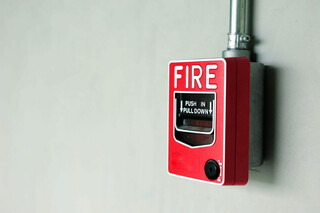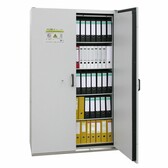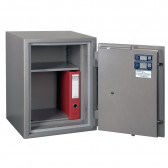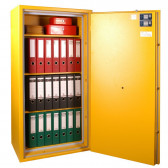A fire can break out in any office or production plant. Will your most important documents remain unthreatened in such a situation? And is your staff safe if there are flammable materials on the premises? What is worth knowing about fireproof cabinets and safes?
Fireproof cabinets are designed to store hazardous materials. Safes, on the other hand, are used to store important materials which should not be destroyed. Both devices are subject to different standards due to their different functions.
When buying fireproof cabinets and safes, the first thing to bear in mind is that both devices have different purposes:
1. Fireproof cabinets are primarily intended to reduce the risk of fire by securing flammable materials, prevent leakage of such materials, minimise the penetration of harmful vapours into the environment, protect the contents of the cabinet from fire and allow time for personnel evacuation or firefighters to carry out a safe fire-fighting and rescue operation before the secured materials lead to an uncontrolled explosion;
2. In the case of fireproof safes, their use is dictated primarily by the desire to protect the contents from destruction. The contents usually do not pose a threat to employees or the environment.
The EN 14470-1 standard for fire resistant cabinets
It defines the level of protection which a fire resistant enclosure must meet in order to be put into use as intended. The primary task of the device is to protect the materials inside in the event of a temperature increase for a specific period of time. This is to prevent the substances stored in the cupboard from immediately exploding, and to allow personnel to leave the room. Every cabinet certified to EN 14470-1 also bears the GHS warning pictograms, which inform the fire brigade about the contents of the cabinet. The cabinet is first removed from the hazardous area by the fire brigade.
Depending on how long the contents of the cupboard can survive intact before the temperature inside it reaches 180 K, the devices are referred to as Type 15, 30, 60 or 90 cupboards. There is therefore no such thing as a completely fireproof cupboard. An increase in ambient temperature in the event of a fire will always lead to an increase in the temperature inside the unit.
Check out: cabinets for hazardous materials at Hartmann Tresore
Standards PN-EN 1047-1 and PN-EN 15569 for fireproof safes
They specify the level of protection of documents stored inside the safe in the event of a fire. This level depends – as in the case of fireproof safes – on the time needed for the documents stored inside to be destroyed. Currently there are two standards in Poland: PN-EN 1047-1 and (much less restrictive) PN-EN 15569. The PN-EN 1047-1 standard has several types:
S 60 P – means that in the event of a fire, paper documents stored in a safe or cabinet are safe for 60 minutes after the fire breaks out;
S 120 P – means the same, but for 120 minutes;
S 60 DIS – means that, in the event of fire, the data media stored in the container are safe for 60 minutes;
S 120 DIS – means the same but for 120 minutes.
When choosing a safe that is to be fireproof, it is therefore necessary to check whether it meets the relevant standards and has been approved, and to decide for how long it should provide protection (and what will be stored in it). If you decide to buy a fireproof safe, you should choose those which have been certified in accordance with the criteria of the PN-EN 1047-1 standard. This is a standard which sets much stricter requirements for safes than the PN-EN 15569 standard. In accordance with the requirements of the PN-EN 1047-1 standard, the safe is not only put into an oven for an hour or two, where it is subjected to a temperature of 1090 degrees Celsius, but after this time it is subjected to an impact test and returns to the oven for the time of its cooling down. The test therefore lasts not one or two hours but a total of over 24 hours. The percussion test consists of dropping the red-hot safe (immediately after removing it from the furnace) onto solid ground from a height of 9.15 m. Both the impact test and the furnace cooling down phase are intended to simulate real conditions that may occur during a fire. This is because structural damage and ceiling collapse may occur (especially in wooden buildings or buildings with wooden ceilings), and the high temperature in the ruins may persist long after the fire has been extinguished.
Moreover, the interior of a fireproof safe is sealed during a fire thanks to seals between the door and the safe's frame, and it is well known that water or other means used to extinguish a fire can be as destructive to documents or other information carriers stored in the safe as the fire itself.
We also recommend: Fireproof safe – which one to choose?
Fire resistant cabinet for documents and other valuable items
Small home fireproof safe as standard equipment for the home






